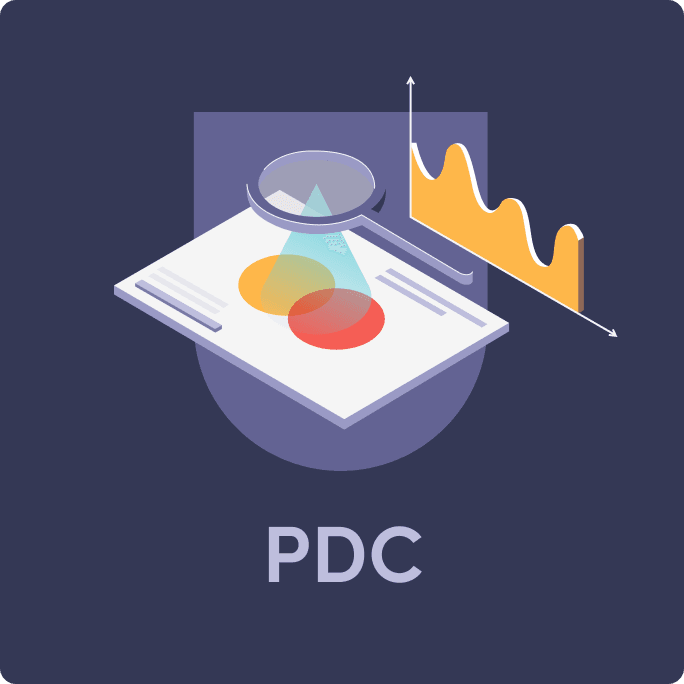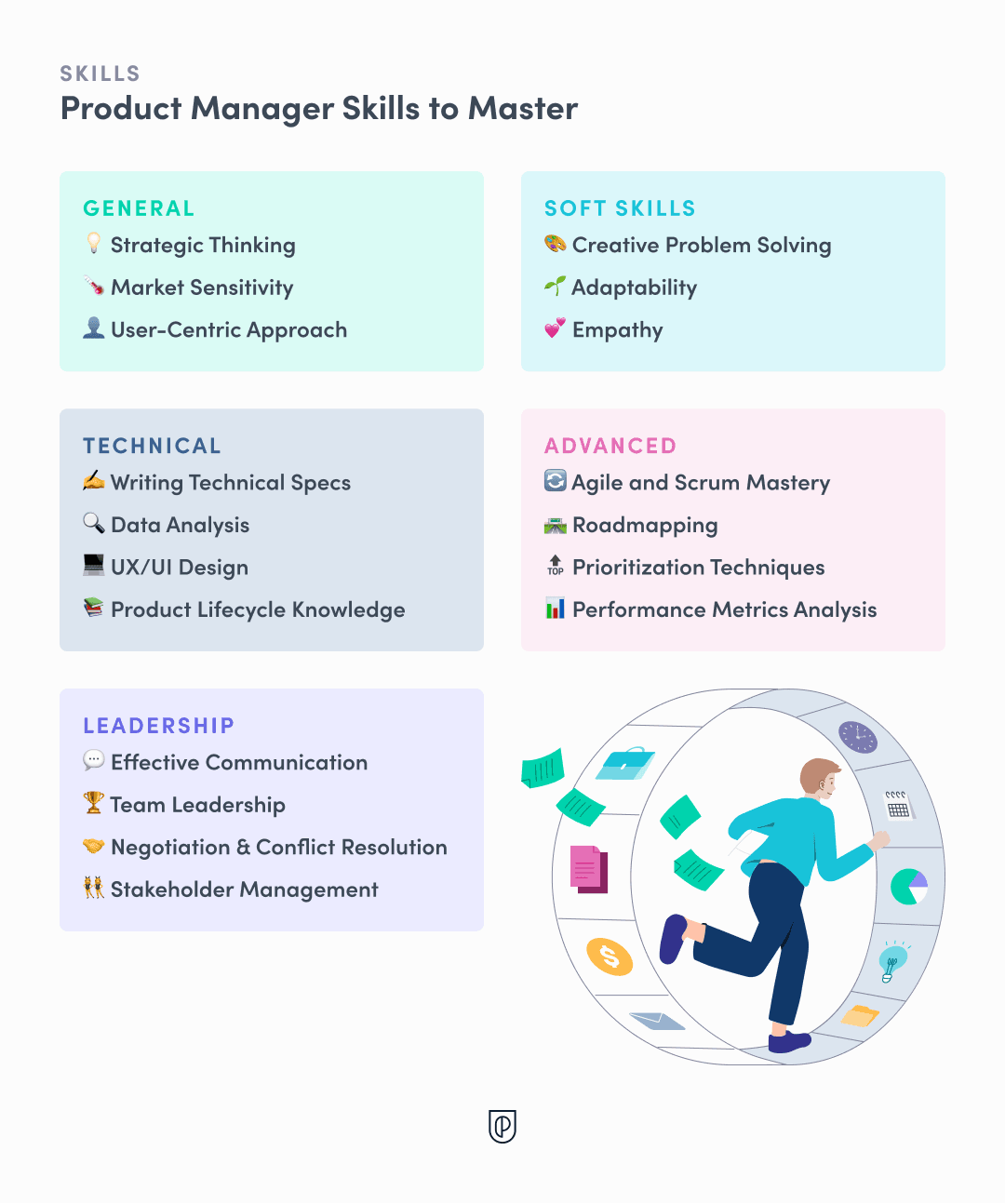Updated: December 18, 2025- 23 min read
In 2026, AI can accelerate development, but it cannot decide what to build. That remains the distinct and critical responsibility of the Product Manager.
Product management is the practice of guiding a solution from a raw concept to market success. It requires balancing technical feasibility, business viability, and user value to ensure the product actually serves a purpose. In this guide, we provide an overview of product management, breaking down the essential skills and strategies that define the role today.
Product Discovery Micro-Certification (PDC)
Master the art of product discovery! Learn how to identify real user problems, validate solutions, and ensure your product truly resonates with its target audience.
Enroll for free
What Is Product Management? A Key Role in Tech
Everyone should, in a product role, be spending a lot of time with customers. It's something you should measure and should be part of your success criteria for your team.
— Trisha Price, CPO at Pendo, on The Product Podcast.
A Brief History of Product Management
Product management traces its origins back to the early 1930s at Procter & Gamble (P&G), where the concept of “brand management” was first introduced. P&G assigned managers to oversee individual brands and be the voice of customers internally. The shift made marketing way more efficient. This approach evolved over time, expanding beyond marketing to encompass the product lifecycle.
In earlier PM days around the 2000s, especially in smaller companies, product roadmaps were entirely customer-driven. Every project was subject to change based on client demands. Furthermore, the size of a deal often dictated priorities, making it challenging to maintain a consistent strategic direction.
The description of product management today is one of a more balanced and strategic discipline. Modern roadmaps incorporate not just customer needs but also long-term strategic projects. While the value of individual customers is still important, it is no longer the sole driving factor. Time is now deliberately allocated for both discovery and implementation, ensuring that products are not only responsive to current needs but are also innovative and forward-thinking.

Today, Product Management is crucial in various industries, particularly in companies that create and deliver products, whether physical or digital. Tech firms, software companies, consumer goods manufacturers, and even service providers rely on product managers to ensure products appeal to customers.
Product Management Definition
Product Management is all about guiding a product from its initial idea to its final release and beyond. It involves understanding what customers need and what the product should do, as well as working with various teams in design, engineering, and marketing. Product Managers (PMs) have the responsibility to steer the product in the right direction. They stay on top of customer feedback, market trends, and business goals to be able to do this.
A PM also has to balance the product vision with what’s possible — both technically and within the business’s goals. While they don't have direct authority over product development or engineering teams, they are the ones responsible for managing the product and ensuring its success.
The goal is to keep the product on course toward a successful launch. Then, it is time to continue to refine and improve. This nuanced role requires a blend of creativity, strategic thinking, and leadership to bring the product to life and keep it thriving.
Strategic Functions and Significance of Product Management Process
The Product Management process ensures that the products a company creates are valuable, viable, and feasible. By focusing on what customers really need and market fit, product management helps the company avoid wasting time and resources on products that don’t resonate.
Moreover, product management keeps the company agile and responsive. As markets change and customer preferences shift, product managers help the company adapt. Here’s what their strategic role within the organization encompasses:
Researching Customer Needs: One of a product manager's foundational roles is to deeply understand what customers want. This involves gathering and analyzing data, conducting user experience research, conducting market research, and getting direct feedback from users. By knowing what customers need, product managers can guide the development of products that truly resonate with their audience.
Understanding the Market and Customers: Product managers also study the broader market to understand trends, identify go-to-market opportunities, find product-market fit, and keep an eye on competitors. This broader perspective ensures that the product not only meets current customer needs but also anticipates future demands.
Setting the Product Vision: With a clear understanding of the market and customer needs, product managers craft a vision for the product. This vision serves as a guiding star for the team, outlining what the product should achieve and how it will stand out in the marketplace.
Aligning with Business Goals: Product managers make sure that the product aligns with the company’s overall objectives. Whether it’s increasing revenue, expanding market share, or enhancing the brand, the product must contribute to the company’s long-term success.
Prioritizing Features and Roadmaps: Since resources are limited, product managers must decide which features or updates to prioritize. They create a product roadmap that balances customer needs, market opportunities, and business goals, guiding the team on what to focus on and when.
Coordinating Cross-Functional Teams: Product managers work closely with various teams—design, engineering, marketing, and sales—to turn the product vision into reality. They work with cross-functional teams to ensure everyone is on the same page, moving in the same direction, and working together effectively.
Monitoring Performance: After a product is launched, the job isn’t done. Product managers continuously monitor the product’s performance and observe the analytics. They gather data on how it’s being used and whether it’s meeting its goals. This ongoing analysis helps them make necessary adjustments and improvements over time.
Product Roadmap Template
Download our easy-to-use template to help you create your Product Roadmap.
Get the Template
Methodologies Associated with Product Management
Frameworks provide essential structure for problem-solving and decision-making in product management. They offer a systematic approach to addressing complex challenges and ensure alignment with strategic goals.
— Francois Ajenstat, CPO at Amplitude, on The Product Podcast
In product management, certain methodologies help teams stay organized and focused on delivering the best possible products. Some of the most common ones include:
Agile: This is a flexible, iterative approach where products are developed in small increments, allowing teams to adapt quickly to changes and feedback.
Scrum: A specific Agile framework that breaks work into manageable “sprints,” usually lasting a few weeks, with regular check-ins and adjustments.
Lean: Focuses on delivering value by minimizing waste and maximizing efficiency, often used to quickly test and validate ideas via a Minimum Viable Product (MVP) before fully committing to them.
Waterfall: A more traditional, linear approach where each phase of development is completed before moving on to the next. It’s less common in modern product management but still used in certain industries.
These methodologies help product managers navigate the complex process of bringing a product from concept to market, ensuring it meets customer expectations and business goals.
Product Management Tools
Product Managers rely on a specialized tech stack to strategize, analyze, and collaborate. While the list of product management tools is very long, they generally fall into a few key categories:
Roadmapping & Strategy: Tools like Productboard, Aha!, and Airfocus help PMs visualize the product vision and align it with stakeholder goals. They allow you to connect high-level strategy directly to delivery items.
Collaboration & Documentation: Notion and Confluence serve as the "brain" of the product team, housing PRDs (Product Requirement Documents) and meeting notes. Meanwhile, whiteboarding tools like Miro and FigJam are essential for remote brainstorming and user journey mapping.
AI & Rapid Development: The line between PM and engineer is blurring. PMs now use LLMs (like Claude or ChatGPT) for strategy and content (like PRDs), while "AI Engineer" tools like Lovable, Bolt, and Cursor allow PMs to spin up functional web apps and prototypes in minutes. Additionally, automation platforms like n8n enable PMs to build complex workflows without burdening the engineering team.
Product Analytics: Understanding how users interact with your product is non-negotiable. Amplitude, Mixpanel, and Pendo provide deep insights into user behavior, retention, and feature adoption, allowing for data-driven decisions.
Project Management & Issue Tracking: To manage the day-to-day execution of sprints and backlogs, Jira and Linear remain the industry standards for engineering collaboration.
Design & Prototyping: While primarily for designers, PMs frequently use Figma to review high-fidelity mockups or Balsamiq for quick, low-fidelity wireframing to communicate ideas visually. However, as stated above, PMs now leverage AI design tools to generate near-complete UI mockups instantly. This allows PMs to bring a "living" concept to designers rather than a rough sketch, significantly speeding up the feedback loop.
AI Prototyping Certification
Go from idea to prototype in minutes. Build, debug, and scale AI prototypes with the latest tools to integrate APIs securely and hand off to engineering fast.
Enroll now
AI in Product Management
AI for product managers no longer refers to a feature we build into products; it is a critical lever for how products are built. AI has shifted from a novelty to a daily "co-pilot" for effective Product Managers.
Automating Discovery: AI tools can now process thousands of unstructured customer support tickets, sales call transcripts, and survey responses to identify trending pain points. This shifts the PM's job from "gathering data" to "acting on insights."
Rapid AI Prototyping: The days of waiting weeks for a "Hello World" MVP are over. PMs now use builder tools like Lovable, Bolt, and v0 to generate fully functional web apps and interactive prototypes in minutes. AI prototyping allows PMs to validate value propositions with real code before a single engineer is assigned to the project.
Multi-Agent Systems: We are moving from single-prompt interactions to Agentic workflows. A PM now designs systems where multiple specialized AI agents collaborate—for example, one agent "Researcher" gathers data, a second agent "Analyst" processes it, and a third agent "Writer" drafts the report. Your role as a PM is to orchestrate how these agents hand off tasks and handle errors.
Managing "Evals" (Evaluations): Building with AI is actually pretty easy; making it reliable is hard. AI Evals are the new unit tests for PMs. Defining the right approach, identifying key metrics, and continuous iteration are all key to ensuring AI products enhance user experience without damaging trust.
Deep Data Insights: AI-driven analytics can process vast amounts of unstructured data—such as thousands of customer support tickets or survey responses—to identify trending pain points and sentiment shifts that a human analysis might miss.
Synthetic User Testing: While not a replacement for real human interaction, AI "synthetic users" allow PMs to stress-test value propositions and messaging against specific personas instantly.
Hype to Human
In this playbook, Tricia Maia, Director of Product Management at TED, explains how to leverage AI for products that address real user pain points and elevate your brand.
Download the playbook
What Do Product Managers Do?

A Product Manager has a diverse set of duties, all of which revolve around identifying what customers need and ensuring that new products or features align with the company’s big-picture goals. They define what success looks like for the product and lead a cross-functional team to turn that vision into reality.
Product Manager Responsibilities:
Identify and prioritize the key requirements for specific product features.
Investigate customer challenges and conduct in-depth root cause analysis.
Collaborate closely with design teams to enhance the overall customer experience.
Develop and implement a comprehensive product strategy.
Guide and influence cross-functional teams throughout the product development process.
Oversee and maintain the product roadmap and manage product releases.
Clearly understand and articulate the product’s value propositions.
Spot and address any gaps within the product offering.
Generate new product concepts based on thorough research and data analysis.
Formulate pricing and positioning strategies in partnership with Product Marketing or Demand Generation teams.
Work in tandem with engineering teams to ensure seamless product development.
Collaborate with PR and marketing teams to effectively manage product launches.
Serve as the product’s ambassador and represent the company at public events.
Free Value Proposition Canvas
Learn how to take user problems as the foundation of your solution and only build products that matter with our free Value Proposition Canvas!
Get Yours Now
Product Manager Skills

Product Management skills span across general, technical, and leadership domains, ensuring you’re well-equipped to guide products from idea to launch effectively.
Strategic Thinking: Aligning product vision with company goals and market opportunities.
Creative Problem Solving: Finding innovative solutions to complex challenges.
Market Sensitivity: Staying attuned to market trends and customer behaviors.
Adaptability: Flexibility to adjust strategies in response to changing circumstances.
AI Literacy: AI prototyping to visualize concepts instantly, orchestrate AI agents to automate complex workflows, and conduct rigorous AI evals to ensure your models perform reliably.
User-Centric Approach: Balancing user needs with product and business needs.
Empathy: Understanding and relating to customer pain points and team dynamics.
Writing Technical Specs: Clearly documenting product requirements and specifications.
Agile and Scrum Mastery: Proficient in Agile methodologies to manage and deliver projects efficiently.
Technical Data Fluency: A working knowledge of product data management via SQL or Python allows PMs to query databases directly to answer questions, reducing dependency on data analysts and enabling faster decision-making.
Roadmapping: Developing and maintaining strategic product roadmaps.
UX/UI Design: Understanding user experience and interface design principles.
Prioritization Techniques: Skillfully managing the prioritization of tasks and features.
Product Lifecycle Knowledge: Comprehensive understanding of each phase of the product lifecycle.
Performance Metrics Analysis: Evaluating performance through key product metrics.
Effective Communication: Clearly conveying ideas and information to diverse audiences.
Team Leadership: Leading cross-functional teams with vision and motivation.
Negotiation & Conflict Resolution: Navigating and resolving conflicts to keep the project on track.
Stakeholder Management: Building and maintaining strong relationships with all stakeholders.
Growth Metrics Cheat Sheet
Master the metrics you need to keep things moving 'up and to the right'! Our Growth Metrics Cheat Sheet covers 45 metrics to measure success at every stage—from acquisition to revenue and referral.
Get the Cheat Sheet
What Are the Different Types of Product Managers?
It's very important to sometimes slow down, to speed up, to really be reflective and think about where you want to go and the tools that you need to build up.
— Yi-Wei Ang, CPO at Talabat, on The Product Podcast
When considering a career, it’s important to take your time and really think about which role fits your strengths and passions. The right choice can lead to a rewarding journey — the one where you’re not just working, but thriving. And a decent pay check doesn't hurt, either, so we'll cover product manager salaries in this section.
A (1) Product Manager is the cornerstone of product development. They traditionally oversee everything from initial concept to market launch. They wear many hats. They juggle tasks like defining product strategy, working with cross-functional teams, and ensuring the final product meets customer needs. Consider them a jack of all trades and masters of none. With an average salary of around $120,000/year, this role is perfect for someone who enjoys being at the center of the action, balancing technical, business, and customer perspectives.
A (2) Technical Product Manager is the ideal role for someone with a strong technical background, ideally in software engineering or IT product management. They focus on bridging the gap between the technical and business sides. Their job is to make sure that products are both feasible and aligned with market demands. With an average salary of about $135,000/year, this role is well-suited for those who love getting into the technical details while also considering the bigger picture.

The (3) Growth Product Manager is all about driving user acquisition, retention, and overall product growth through Product-Led Strategies. This role involves experimenting with different approaches to find what drives the most value for the business. With an average salary of around $130,000/year, it’s a great fit for someone passionate about using data to fuel growth and who thrives in a fast-paced, results-oriented environment.

For those who are fascinated by data, a (4) Data Product Manager role might be just the right fit. These professionals focus on products that involve significant data management and analytics, ensuring that data is leveraged effectively to drive product success. With a salary of $125,000/year, this role is ideal for individuals who are detail-oriented and love working with numbers to uncover insights that alter product direction.

As an (5) AI Product Manager, you’re at the forefront of cutting-edge technology, guiding the development of AI-driven products. This role requires expertise in machine learning and data science, with a strong understanding of how to apply these technologies to solve real-world problems. With an average salary of $140,000/year, it’s perfect for those who are excited about the potential of AI and want to be part of tech pioneering.
A (6) Platform Product Manager focuses on building and maintaining scalable systems that can support a wide range of applications. This role involves ensuring that the platform is robust, reliable, and able to integrate with other products. Earning about $130,000/year, it’s ideal for someone who enjoys working on complex systems and ensuring they perform well under various conditions.
The (7) UX Product Manager is dedicated to enhancing the user experience. They work closely with design and research teams to create products that are intuitive and enjoyable to use. This role is perfect for those with a background in UX design or research and who are passionate about putting the user at the center of product development. With an average salary of $115,000/year, it’s a rewarding role for anyone who values making products that delight users.
At the top of the product management ladder is the (8) Chief Product Officer, who oversees the entire product strategy for a company. This executive role involves leading the product management team, setting the vision for the product portfolio, and ensuring that all products align with the business goals. With salaries often exceeding $200,000/year, the CPO role is suited for experienced product leaders who are ready to take on the highest level of responsibility in product management.
If you're interested in exploring more product management roles, we have a full article that lists different types of product management positions. It offers a deep dive into each role, covering responsibilities, skills, and what makes each unique.
The Product Management Hierarchy

The standard product management hierarchy is a structured path that starts from entry-level roles like Associate Product Manager (APM) and progresses to executive positions like Principal Product Manager (PPM) or Chief Product Officer (CPO).
At each level, roles are interconnected, with APMs learning the basics, Product Managers and Senior Product Managers handling more responsibility, and Directors of Product overseeing multiple teams. The CPO sets the overall strategy.
Product Manager’s role overlaps with other positions derived from Scrum methodology. When paired with these roles, Product Managers focus on the broader vision — usually — while Product Owners work closely with development teams to execute this vision.
Product Specialists, on the other hand, offer deep expertise on specific aspects, helping to refine features and understand customer needs. Project Managers ensure that timelines, budgets, and resources are managed efficiently, coordinating with Product Managers and Product Owners to keep projects on track.
Together, these roles ensure that products are developed efficiently, meet customer needs, and align with business objectives. If you're interested in learning more, we have a full article that lists different types of product management positions and offers a deep dive into each one.
Product Management vs. Program Management
Program management, on the other hand, is broader. While a product manager focuses on one specific product, a program manager oversees multiple related projects or products, ensuring they all align with the company’s bigger goals. Program managers coordinate efforts across different teams and products to make sure everything is moving smoothly and efficiently.
In short, program management and product management are different. Product management is about owning a specific product, from idea to launch, while program management is about ensuring multiple products or projects work together towards a common goal.
Product Management Example Use Cases
Product management use cases vary widely across industries but generally revolve around solving specific customer problems or improving business outcomes. For example:
Developing a New Software Feature: A Product Manager identifies a common user pain point in a software application, such as slow load times. They work with engineers to develop a feature that improves performance, leading to higher user satisfaction and retention.
Launching a New Product: A Product Manager in a consumer goods company might oversee the launch of a new product, coordinating market research, product design, and go-to-market strategies to ensure a successful release.
Improving User Experience: In a tech company, a Product Manager might focus on enhancing the user interface of an app, working closely with designers and UX researchers to make the product experience more intuitive and enjoyable for users.
Entering a New Market: A Product Manager could be responsible for adapting an existing product to enter a new geographical market, ensuring it meets local regulatory requirements and resonates with the new target audience.
Managing a Product Roadmap: As the Product Roadmap owner, the Product Manager might prioritize and schedule product updates based on user feedback, market trends, and business goals, ensuring the product evolves in a way that maximizes its value to both customers and the company.
Driving Growth through Data: In a SaaS company, a Growth Product Manager could use data analytics to identify opportunities for increasing user engagement, and implementing A/B testing to optimize features and drive growth.
These examples illustrate how product management is about strategically guiding the development and improvement of products to meet customer needs and achieve business objectives.
Key Product Management Concepts
Understanding the key concepts in product management is essential for guiding a product from idea to market success. Below is a comprehensive list of important concepts, each playing a crucial role in the product development process, from initial planning to continuous improvement and market adaptation.
Product Lifecycle Management: This involves managing a product through its stages from inception, growth, and maturity to decline, ensuring it remains competitive and profitable throughout.
Product Roadmap: A strategic document that outlines the vision, direction, priorities, and progress of a product over time, guiding its development and aligning stakeholders.
Minimum Viable Product (MVP): The most basic version of a product that includes only essential features, released to test the concept and gather user feedback for future development.
Agile Product Development: An iterative approach to product development that emphasizes flexibility, collaboration, and customer feedback, enabling teams to quickly adapt to changes and deliver value incrementally.
Product Personas: Fictional characters that represent different user types, helping product teams understand the needs, behaviors, and goals of their target audience during product development.
Product-Market Fit: The degree to which a product meets a strong market demand, indicating that the product has successfully addressed customer needs and is likely to be successful in the market.
User Journey and User Flow: A visual representation of the customer’s experience with a product, from initial awareness to post-purchase, helping to identify pain points and opportunities for improvement.
KPIs and Metrics: Key Performance Indicators and metrics used to measure a product’s success, such as user engagement, customer satisfaction, and revenue, guiding decision-making and strategy adjustments.
Product Mix: The complete range of products offered by a company, including all variations and categories, which are managed to optimize sales, market share, and profitability.
Product Portfolio: The collection of all products managed by a company, often categorized by market, customer segments, or business units, to balance risk and maximize overall performance.
Product Specification: A detailed document that outlines the features, requirements, and technical details of a product, serving as a blueprint for development and ensuring alignment among teams.
Product Analysis: The process of evaluating a product’s performance, market position, and potential for improvement, often involving competitive analysis, customer feedback, and financial metrics.
Product Experience: The overall experience that users have with a product, encompassing usability, satisfaction, and emotional response, which directly influences customer loyalty and brand perception.
Product Launch Strategy: A strategy for introducing a new product to the market, including marketing, sales, and distribution tactics, to ensure a successful launch and early adoption.
Product Launch Plan: A plan that outlines all the steps and actions needed to successfully introduce a product to the market. It includes timelines, marketing and sales tactics, key messaging, and distribution strategies, and more.
Agile Retrospective: A meeting held at the end of an Agile sprint where the team reflects on what went well, what didn’t, and how to improve in the next sprint, fostering continuous improvement.
Cost of Delay: A metric that quantifies the economic impact of delaying a product feature or launch, helping teams prioritize work based on the potential financial consequences of delay.
Product Discovery: The critical process of determining what to build. It involves validating customer problems and potential solutions through research and testing to minimize the risk of building the wrong thing before development begins.

How to Get into Product Management?
Becoming a Product Manager requires a blend of strategy, skill development, and targeted job search tactics. Whether you're starting from scratch, transitioning from another role, or aiming to land a job, there's a clear path to guide you:
1. Starting with No Experience
If you lack direct experience, focus on building relevant skills. Start by learning the fundamentals through online courses, such as this guide on how to become a product manager. Work on side projects to build a portfolio that showcases your abilities in real-world scenarios.
Networking is crucial—attend industry events, engage in product management communities, and seek mentorship from experienced professionals.
Certifications, like our Product Manager Certification, can further enhance your credibility and help you stand out to potential employers. Additionally, consider volunteering or interning with startups to gain hands-on experience. This experience can be invaluable when transitioning into a product management role.
2. Transitioning Into Product Management from Another Field
Transitioning into product management is about leveraging your existing skills. If you come from marketing, engineering, sales, or another field, identify how your current expertise aligns with product management.
For example, marketers often excel in understanding customer needs, which is critical in product management. Engineers can transition by highlighting their deep technical knowledge, enabling them to effectively communicate with development teams and contribute to product feasibility discussions. They have the perfect skillset for Data Product Manager and Technical Product Manager roles. Salespeople bring a strong customer focus and market knowledge, making them adept at identifying customer pain points and influencing product direction.
Lastly, start by taking on product-related tasks in your current role to build relevant experience, as outlined in this article on transitioning into product management.
3. Landing a Product Management Job
To secure a product management position, tailor your resume to highlight relevant skills and achievements.
Showcase your ability to lead, prioritize, and deliver results. During interviews, be ready to discuss your experience with problem-solving, user-centric thinking, and working with cross-functional teams.
Demonstrate your understanding of product management methodologies and be prepared to articulate how your background uniquely positions you to succeed in the role. For more detailed strategies, refer to this guide on landing a product management job.
Be Intentional And Meticulous
Breaking into product management—whether you’re starting fresh, transitioning, or seeking a new job—requires intentional steps. It's not just about being prepared; it's about being meticulous. It’s what the job asks for, after all…
Therefore, sharpen your skills, lean into your strengths, and make every experience count. Don’t just tell them you're a strategic thinker—prove it by showing how you've driven success. Your journey to product management isn't just another career move — it's a bold step into the driver’s seat of innovation.
Be the one who makes things happen. That’s what makes a great Product Manager.
Product Management Certification
Master the essential PM toolkit: build roadmaps, define PRDs, analyze users, and launch products leveraging the latest AI-first strategies.
Enroll now
Updated: December 18, 2025





